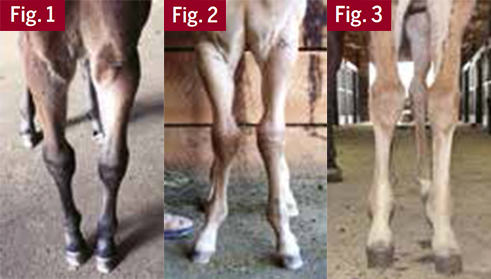In today’s breeding environment, raising a foal to sell at a yearling sale or race at 2 routinely requires some type of veterinary or clinical assistance regarding conformation.
Even if it is only to add another set of eyes to the process, I believe it to be valuable information. I have never found it to be wrong to add the opinion of a veterinary practitioner or surgeon. Since they are already involved at the farms, within the breeding process, why not take a moment to get that person’s opinion? The more looks we can get on a foal, the better the potential outcome will be.
Even where conflicting opinions exist, I still believe that more attention is always better in the process of evaluation for a developing young horse. In those cases in which the veterinarian and farrier do not agree, the situation causes each person to look at the animal more intently than otherwise. What could possibly be wrong with that?
The study of veterinary medicine involves the language of science and anatomy. The earliest recorded writings of Western medicine were from the Greek physician Hippocrates, who lived for 90 years between 460-370 BCE. After the Roman conquest of Greece, the Latin influence was introduced to medical science.
Today, Greek and Latin still dominate medical terminology. One reason is that these languages lend themselves to compounding words easily. Compounded words can give the identification, description and location of a medical condition within one name. Once learned, these ancient medical terms can make the dialogue of anatomy and physiology more efficient. This explains the long-term usage of an otherwise dead language.
As a non-academic, it can be intimidating or frustrating to not understand the language sometimes used by a professional. In their defense, many vets or other professionals simply use the language they learned during many years of classes, lab, and field work. It is second nature for them and not meant to overwhelm the rest of us. Understanding a few of those terms can help us laymen more easily pick up on much of the lingo of professional conformational evaluation.
Here are the terms most often used for lower limb conformation: “Varus” describes a toed-in conformation, while “valgus” describes a toed-out conformation. The terms “varus” or “valgus” can apply to knees (carpal), hocks (tarsal), or fetlocks. The possible description of a foal could be “carpal varus” and “tarsal valgus.”

Fig. 1 shows carpal varus. Tarsal varus would be the same type of conformation in the hocks.
Fig. 2 shows carpal valgus and, as before, tarsal valgus for the same conformation in the hock. The terms “varus” and “valgus” can apply to fetlocks as well. Since the medical term for fetlock is the metacarpophalangeal joint, most people from the barn and the clinics just say “fetlock varus” (toed in) or “fetlock valgus” (toed out). Fetlock valgus and tarsal varus in foals are both rather uncommon.
Fig. 3 shows carpal valgus and fetlock varus in the same leg. Some surgeons have referred to this as a “Z-leg.” The trick to addressing a Z-leg is to make certain the deflection from a valgus knee (carpus) does not create or accentuate the varus fetlock. This is because fetlocks need to be addressed before 90 days of age, while knees can still be helped into the yearling season for that horse.
Getting comfortable with some of the terminology professionals are using can be a significant advantage when dealing with issues related to the horse. Taking the time to learn these terms well can improve the relationship between you and the pros. It is always a better relationship when two sides are speaking the same terms in any format.
If we can talk the talk, hopefully our horses might better walk the walk.
Veteran Standardbred farrier Steve Stanley of Lexington, Ky., authors a monthly column for Hoof Beats, the official harness racing publication of the U.S. Trotting Association. The American Farriers Journal Editorial Advisory Board member offers plenty of practical advice that will be of special interest regardless of the type of horses that you work with. Click here to read more from Steve Stanley's Hoof Beats series.








Post a comment
Report Abusive Comment